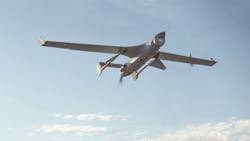Navy asks IMSAR to build multi-mode radar for small UAV able to track moving targets on the ground
LAKEHURST, N.J. – U.S. Navy unmanned surveillance experts needed a synthetic aperture/ground moving target indicator (GMTI) radar for small military unmanned aerial vehicles (UAVs). They found their solution from IMSAR LLC in Springville, Utah.
Officials of the Naval Air Warfare Aircraft Division in Lakehurst, N.J., announced a $7.3 million one-year order to IMSAR on Thursday to develop and build the AN/DPY-2 split aces payload systems and communications relay package for the RQ-21A Blackjack UAV.
The DPY-2 radar is based on the IMSAR NSP-5 radar that integrates into the payload bay of the Boeing Insitu RQ-21A Blackjack UAV, which is 8.2 feet long, has a 16-foot wingspan, and weighs 135 pounds with full fuel and sensor payloads.
Related: Army researchers choose IMSAR to develop small radar systems for unmanned aerial vehicles
The IMSAR NSP-5 radar, also called Split Aces, is a synthetic aperture/GMTI radar payload powered by Ku-band NanoSAR synthetic aperture radar technology housed in a pod with enclosed electronically scanned array antennas It is for tracking moving targets on the ground.
The NSP-5 provides high-resolution SAR imagery, coherent change detection, and ground moving target indication, and provides capabilities similar to the U.S. Air Force Joint Surveillance Target Attack Radar System (Joint STARS), only in a much smaller package for a much smaller aircraft. Joint STARS is based on the Boeing 707 commercial passenger jet.
The NSP-5 radar is 45.3 inches long, 5.4 inches in diameters, weighs 16 pounds, and consumes 150 Watts of power. It's designed to detect, track, and target columns of enemy infantry and combat vehicles moving on the ground in all-weather conditions, during the day and at night.
Related: Army extends support for UAV man-hunting radar from Northrop Grumman through 2013
The system also has GMTI capability and synthetic aperture radar to image personnel or vehicles. Non-military roles of this radar also could include border security and search and rescue.
This order is part of a Small Business Innovation Research (SBIR) project, begun in 2012, called Advanced Radar Concepts for Small Remotely Piloted Aircraft.
On this order IMSAR will do the work in Springville, Utah,, and should be finished by October 2020. For more information contact IMSAR online at www.imsar.com, or the Naval Air Warfare Aircraft Division-Lakehurst at www.federallabs.org/labs/naval-air-warfare-center-nawc-aircraft-division-lakehurst.

John Keller | Editor-in-Chief
John Keller is the Editor-in-Chief, Military & Aerospace Electronics Magazine--provides extensive coverage and analysis of enabling electronics and optoelectronic technologies in military, space and commercial aviation applications. John has been a member of the Military & Aerospace Electronics staff since 1989 and chief editor since 1995.

